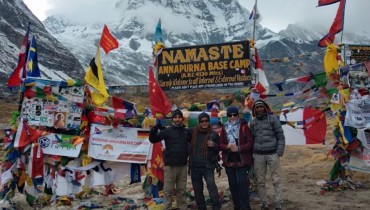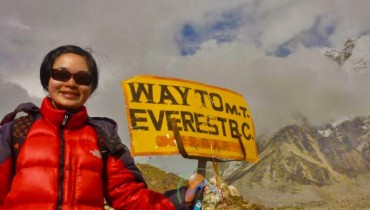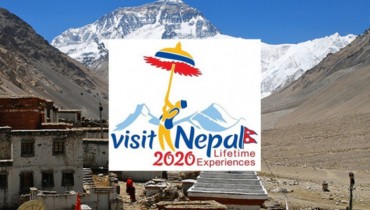How hard the Everest Base Camp Trek might be?

Trekking to Everest Base Camp is moderate to fairly challenging journey. You can do this hike with ease if you are in generally good health, can climb stairs, and can walk for a few hours without getting tired. The average daily walking time is 5 to 6 hours. The maximum elevation you will encounter on the trek is Kala Patthar, which is 5545 m /18192 ft. The trail is easygoing, however, there are some serious uphill climbs and downward descents. On an unpaved gravel path, you stroll. There are no complex movements required; merely easy walking.
One thing immediately comes to mind when you hear or see the phrase "Everest Base Camp"—the gigantic Everest. The best trek in the world to get you to Everest's base camp is the one to Everest. Every trekker has long had this trek on their list of must-do adventures.
To experience the thrill of the world's highest mountain thousands of trekkers travel to the Everest region every year. Most likely, if you are a traveler and EBC trek is on your bucket list one thing is certain: before taking a flight to Nepal, you would think about “How hard the Everest Base Camp Trek might be?” That question will also be addressed in this blog. Find a comfortable spot to read this blog, pour yourself a cup of coffee, and relax there while you wait for the answer.
The Everest Base Camp Trek is much more than just a trip to Everest. The locals and their way of life, the surrounding natural beauty and culture, bonding with other trekkers, Sherpa hospitality, mountain tales, monasteries, and the mountains are all discussed in one journey. Trekkers can enjoy the stunning vistas of some of the world's highest mountains, including Everest. It is, in a word, a once-in-a-lifetime trek. And for precisely this reason, the Everest Base Camp Trip is undoubtedly the most well-liked trek worldwide. Everyone desires to visit the Everest base camp at least once in their lifetime, whether they are young or old.
But one question struck people hard: “How hard is the trek to Everest Base Camp? Let us provide the response: The trek is challenging for those who believe they cannot complete it. Otherwise, even a non-experienced person with ordinary fitness can complete it. They actually accomplished it. In many social media posts, a smiling child is seen posing at Everest Base Camp. This proves you could be the next.
Did you know that each year, hundreds of trekkers of all ages fly from Kathmandu to Lukla before making the days-long journey through the Khumbu valley to the base camp? This obviously indicates that you can complete the walk if you have a strong will to do so and have made the necessary preparations.
The typical Everest base camp trip takes 13 days to complete, including days for acclimatization at Namche and Dingboche. Every day, you will be on foot for 5 to 6 hours in mountain terrain. As already mentioned above, it’s possible to accomplish this trek without any technical expertise or prior high-altitude trekking experience. However, there are a few things you need to keep in mind for a successful EBC trek regardless of the difficulty level. Without further delay, let's examine the factors contributing to the difficulty of the Everest Base Camp Trek.
Elevation
The trek takes you to a height of 5545m /18192ft at Kala Patthar, starting from Lukla at 2,800m/9,186ft. You will gain between 400m and 800m per day while trekking for 5 to 6 hours on average. Altitude sickness, which is brought on by high altitude if not adequately acclimatized, could happen at this height. Our bodies are not accustomed to living at high altitudes, making us susceptible to Acute Mountain Sickness (AMS).
Acute Mountain Sickness (AMS):
AMS is the abbreviation for Acute Mountain sickness also termed High Altitude Sickness. AMS is one of the challenges that trekkers/ climbers might face during their climb in the mountains. As you reach a higher altitude the oxygen level gradually decreases. If a person tries to climb too quickly then there is a higher chance of getting AMS.
However, AMS can be prevented if you use precautionary measures. Drinking plenty of water (4-5 liters per day) and eating plenty of food (4000-5000 calories per day) and walking smoothly can be basic precautions. Our experienced guides who have been working in the Himalayas for several years with their expertise in implying proper trekking techniques like Climb High Sleep Low for proper acclimatization, these veteran guides will lead you to your destination making it a memorable trip of your lifetime. They will guide you with your food habits in the Himalayas. They will care about your walking pace and they treat you in the friendliest manner so that you will listen to their guidance properly.
While, trekking in the Himalayas, you will walk in the Ups down trail taking you to an elevation of over 2500 m. Hence, you might feel difficult to breathe or your breathing speed up. Hence, it is most important to familiarize yourself with the altitude and let you adjust to the decreased availability of oxygen at high altitudes. Our itinerary is designed with sufficient days to acclimatize. In case of gaining a certain height, there is a rest day when you can explore the area as well as walk to high altitude and sleep at low land. Likewise, you are suggested to walk slowly and carefully without getting any stress. Also, for proper acclimatization, you should care about your eating habits. Don’t focus on Junk food and eat as much liquid as possible. Hard drinks are not recommended. The right way to acclimatize properly is 'walk high-sleep low'.
There are some preventive medicines for altitude sickness prevention and treatment. It allows you to breathe faster so that you metabolize more oxygen, thereby minimizing the symptoms caused by poor oxygenation. This is especially helpful at night when respiratory drive is decreased. While using preventive medicine, it is advisable to start taking it 24 hours before you go to altitude and continue for at least five days at a higher altitude. The recommendation of the Himalayan Rescue Association Medical Clinic is 125 mg. twice a day (morning and night). (The standard dose was 250 mg. but their research showed no difference for most people with the lower dose, although some individuals may need 250 mg.) Possible side effects include tingling of the lips and fingertips, blurring of vision, and alteration of taste. These side effects may be reduced with the 125 mg. dose. Side effects subside when the drug is stopped. It is more appropriate to contact your physician for a prescription. Since Diamox is a sulfonamide drug, people who are allergic to sulfa drugs should not take Diamox. Diamox has also been known to cause severe allergic reactions in people with no previous history of Diamox or sulfa allergies. Frank Hubbell of SOLO recommends a trial course of the drug before going to a remote location where a severe allergic reaction could prove difficult to treat.
What should you do to avoid getting altitude sickness?
- Avoid smoking and consuming alcohol.
- Sleep at a lower altitude in a teahouse.
- Consume a lot of water every day.
- Make sure acclimatization days are included in your schedule.
- If you see any AMS symptoms in your body, descend right away.
Trekking Distance and Daily Walking Distance
Now, you might find this a little puzzling! But hold on, this length refers to the overall 130km that you would go while walking for days to the base camp. That's a lot! We are aware. Given that you'll be walking for about 10 days, you'll cover an average of 12 kilometers per day.
It can be challenging for some hikers who are not accustomed to long hikes to cover this distance. The difficulty of the Everest Base Camp Trek is heightened by the fact that you'll be traversing uneven terrain, climbing and descending, and daily gaining a certain amount of altitude. This implies that you must be physically capable of hiking for hours while carrying a light backpack along mountain paths. You can still complete this, even if you have no prior hiking experience.
It could be a difficult task for you because you'll be hiking upward for several days. But as we just stated, you may complete the world's best journey if you have a solid commitment to doing so and a well-thought-out plan. Think about spending a few hours each day for about a month walking around your hometown while carrying a small backpack. Take into consideration quick country hikes. Or perhaps think about working out every day. You can consider these as a part of training.
How to prepare for this trekking?
The most common question I get when people inquire about my treks is, “How do you train for Everest Base Camp Trek?”
Most people feel that they need a year or two to get ready. If you walk a lot, love the outdoors and have a sense of adventure you can be ready in 6 months.
One does not need to be a major sports person to trek to the Everest Base Camp Tours, however, physical fitness is important! Our treks are not running competitions. We feel it’s important for you to be able to walk at your own pace so that you can enjoy the natural beauty around you! Trekking the trails of Nepal offers a diversity of landscape, flora and fauna, people and culture.
To really experience the wonders of Nepal and enjoy your trek you must be physically and mentally prepared!
If you are physically fit, you will be able to enjoy more and have enough energy for extra activities when you get to the quaint villages and tea houses.
Trekking is available to anyone, you just have to be sensible and work a bit for it. Here are a few tips to get started in your training.
1. START WALKING!
In Nepal, most of the adventure trekking trails are quite uneven. You will be trekking in both lower and higher altitudes. You will also be trekking under the hot sun as well as the chilly nights. The best way to get ready for a long trek such as the Everest adventure trek is to start taking long walks. Don’t just walk on beautiful days, walk in the rain, hot sun, wind or snow! Talk to your trek leader. Find out how many hours a day you will be walking. Ideally, you want to be able to walk 4-6 hours comfortably a few days in a row before you leave for your adventure.
2. AEROBIC TRAINING
Aerobic training is also important for trekking in Nepal. To improve your cardiovascular fitness it’s good to focus on high-intensity training followed by a recovery period. How do you do that? Honestly, stairs. Find a set of stairs that takes you 1-2 minutes to get up to the top or a steep hill. Start low, maybe 3-5 sets – you want to start breathing heavily – work your way up to 10 sets. Always allow recovery time in between. Need it harder? Grab your backpack. That’s a great way to not only train but to make sure it fits correctly and doesn’t pull on your shoulders. Are you into cross-training? Want to mix it up? Throw in cycling/spin with some squats and lunges. Get those legs moving and the heart rate up, but please make sure you warm up and stretch before and after any training you do!
3. LIGHT WEIGHT TRAINING
On most treks, you won’t be carrying your main pack, but you will need to carry a small day pack with essentials like your camera, snacks, sunscreen, water and wet-weather gear/layers. So, with all your days/weeks/months of a training challenge yourself with a weighted bag. If you really want to challenge yourself, pack your bag with a few extras so it’s a little heavier than what you are planning to pack for your trip. This will get you used to carry your gear.
4. HIKING GEAR
Invest in a pair of good-quality, water-resistant hiking boots. Make sure they have plenty of support and ventilation. Your feet are the most important piece to trekking. Train in your hiking boots when you can. Get your feet, ankles and legs used to your boots. Wear them everywhere! They will feel a bit heavier and maybe even a bit clumsy compared to your tennis shoes. Very important - try to get as many miles/hours in them as you can.. Push yourself to walk on different terrains. Hike off-road. Try to train on surfaces that will be similar to the trails on your upcoming trek. Talk to your guide – they can really be helpful! Lastly, make sure you stock up on good hiking socks. I prefer a wool/nylon blend. Socks can make a huge difference in preventing blisters!!!
5. FUEL UP AS YOU TRAIN
We are so used to sitting and eating our 3 meals a day…. When you are trekking you eat as much as you go. It’s SO important you are stocked with enough water and snacks during a trek. Most treks including the Everest adventure treks stop for lunch however it’s good to have nuts, dried fruit, your favorite protein bar, and even chocolate on hand. I love hard candies too. Sometimes the air is so dry it’s nice to have a flavored hard candy to change things up. Also, always have a reusable water bottle. Hydration is key! While in training mode tries to eat and drink “on the go” as much as you can so your body can get used to digesting during strenuous exercise.
Trekking Itinerary
The success percentage of the expedition is significantly influenced by your trek itinerary. You must include at least one acclimatization day in your regular itinerary. Acclimatization days are included in the majority of EBC trek itineraries in Namche and Dingboche. The following is the most commonly practiced itinerary:
Day 01: Arrival in Kathmandu (1,300m/4,264ft)
Day 02: Trek preparation day
Day 03: Fly to Lukla (2,800m/9,186ft) & trek to Phakding (2,652m/8,700ft), 3-4hrs
Day 04: Trek to Namche Bazaar (3440m/11,283ft), 5-6hrs
Day 05: Acclimatization day at Namche
Day 06: Trek to Tyangboche(3,867m/12684ft), 4-5hrs
Day 07: Trek to Dingboche (4,358m/14,295 ft), 5-6hrs
Day 08: Acclimatization day at Dingboche
Day 09: Trek to Lobuche (4,928m/16164 ft), 5-6hrs
Day 10: Trek to Gorakshep (5,160m/16,929ft) & hike to Everest Base Camp (5,320m/17,450ft) 6-7hrs
Day 11: Early hike to Kala Pathar (5550m/18,204ft) & Trek back to Pheriche 6-7hrs
Day 12: Trek to Kyanjuma(3,500m/11,480ft), 5-6hrs
Day 13: Trek to Khumjung to Monju (2,850m/9,348ft), 6-7hrs
Day 14: Trek to Lukla (2,800m/9,186ft), 4-5hrs
Day 15: Fly back to Kathmandu (1,300m/4,264 ft)
Day 16: Departure from Kathmandu
In conclusion
The trek to Everest Base Camp is feasible. Anyone in good health can choose to go on this expedition, regardless of experience level. Before setting off on a journey to the base camp of the world's tallest peak, you must, however, take into account the aforementioned factors. You can get in touch with us if you have any inquiries about the Everest Base Camp Trek. You can plan and get ready for the journey to Everest Base Camp with the aid of our travel advisor.
Dream Big! Dream Travel!
Quick Inquiry

Annapurna Base Camp Trek Guide

Everest Base Camp Trek- An Adventurous and Joyous Trekking ever


